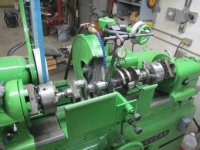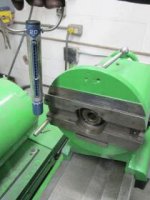Hanz
Cast Iron
- Joined
- Feb 2, 2003
- Location
- Casselberry, FL
I recently aquired an old Storm Vulcan model 14, the predicessor to the very common 15. Although old, it had little use, and the price was right. After dissassembly, cleanup and reassembly, and tweaking it in, our biggest problem is that it is turning journals .0005 out of round.
My machinist has quite a bit of crankshaft grinding experience, and we also have the original instruction and trouble shooting manual. Most common cause for out of round condition according to it is too much steady rest pressure. But that is not our case here, we have tried just about everything. New bearings, although I didn't think that was the cause. The headstock and tailstock have new wear shims under them, and we have spent quite a bit of time lining them up using the adjustment set screws.
The out of round is very consistant- always there, always right at .0005, and for both rods and mains.
Anyone have any ideas or something that we may have overlooked?
Thanks-Hanz
My machinist has quite a bit of crankshaft grinding experience, and we also have the original instruction and trouble shooting manual. Most common cause for out of round condition according to it is too much steady rest pressure. But that is not our case here, we have tried just about everything. New bearings, although I didn't think that was the cause. The headstock and tailstock have new wear shims under them, and we have spent quite a bit of time lining them up using the adjustment set screws.
The out of round is very consistant- always there, always right at .0005, and for both rods and mains.
Anyone have any ideas or something that we may have overlooked?
Thanks-Hanz



 , but here are some thoughts. My machine is a 15 and I am currently running two chucks, but I may try it without them.
, but here are some thoughts. My machine is a 15 and I am currently running two chucks, but I may try it without them.
